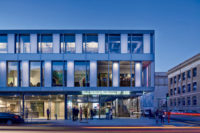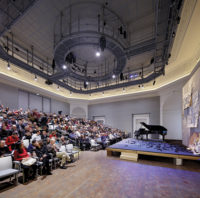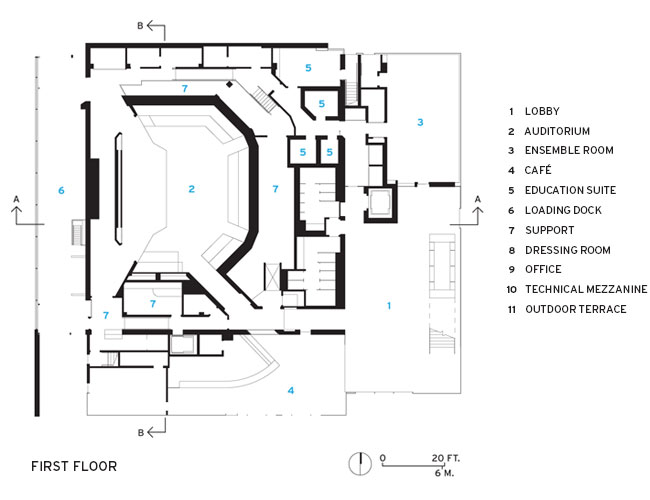SFJAZZ Center
Take it from the top: A new center for jazz in San Franciso was designed by Mark Cavagnero Associates to invite the public in for more than musical riffs.
























Architects & Firms
San Francisco
As a latecomer to San Francisco's performing-arts district, SFJAZZ, a 30-year-old concert series, had to figure out how to fit into the Hayes Valley neighborhood. Working against the backdrop of the Beaux Arts'styled San Francisco Conservatory of Music and War Memorial Opera House, Mark Cavagnero Associates set out to design a modern building for the jazz center that would look as if it had always been there. 'We wanted to lock it into the street,' says principal Mark Cavagnero, 'and to have the sidewalk and the lobby and the caf' all open up into the public realm.' Pointing out the center's diaphanous glass facade, he adds, 'There's no opaque wall between you and the SFJAZZ Center. It's as transparent as we can make it.'
When the new building for SFJAZZ opened in January, it became the first stand-alone venue specifically built for jazz in the U.S. (Jazz at Lincoln Center's Rose Hall in New York is part of the Time Warner Center.) This musical arrival to the neighborhood replaced a muffler shop that had not extended all the way to the sidewalk. To integrate the center into the streetscape, the architects massed the upper two levels of the three-story building to align with those of neighboring structures and pulled back parts of the top floor to echo, in an abstract manner, the pattern of a mansard roof next door. Along the building's south side, a concrete wall bookending the upstairs balcony juts out in front of a neighboring church. To avoid blocking the sun on the church's facade, the architects added a slotted opening that lets daylight through.
The architects conceived the 36,550-square-foot structure as a living room for the neighborhood. The central volume, a concrete box housing a state-of-the-art auditorium, carries the building's entire seismic load so the L-shaped perimeter, containing public amenities, can have as much uninterrupted glass as possible. Such spaces'including porchlike lobbies on the first and second levels, a sidewalk caf' run by restaurateur Charles Phan, and an ensemble room for rehearsals or smaller performances, which are visible to passersby'stay open both day and night.
To build an auditorium that would recall the intimate experience of a jazz club, the architects discarded the traditional shoebox layout with a proscenium stage and a narrow block of seats. Instead, they took inspiration from a nonmusical typology: a cube-shaped community room along the lines of Frank Lloyd Wright's Unity Temple in Oak Park, Illinois (1908). With a customized acoustics system aided by a large steel-tube canopy and baffles behind the musicians, the architects (with theatrical consultants Auerbach Pollock Friedlander) were able to arrange seating on all sides of the performers. Flexible elements, such as movable risers, an adjustable stage, and acoustic screens'which block unfilled seats from view'allow the space to make a transition in scale and configuration from a small dance floor surrounding the musicians to a 734-seat concert hall.
By giving the seats a steep rake, the architects set up a personal relationship between the audience and performers. 'The musicians look at people's faces and not at the tops of their heads,' says Cavagnero. 'They like that feeling of being immersed in the audience. There's a sense of energy they get from a steeply raked house.'
To extend that spirit of exchange to the building edge, the architects used low-iron glass for the facade. Its balance of transparency and reflectivity picks up nearby buildings, trees, and passing cars so that the perimeter seems to dissolve into the cityscape in the daytime. At night, the center's lights restore the building's edge, revealing the activity within. Through a swath of glass that cuts from the caf' to the stage, passersby looking in before a concert can see the piano bathed in a spotlight.
Cavagnero sees the building's relationship with its surroundings as a reciprocal one. 'Once you start engaging the neighborhood,' he says, 'the neighborhood can benefit from you. But you can benefit from it, too.' Using glass on three sides of the second-floor lobby, for instance, makes the narrow, 25-foot-wide hall appear much more spacious. To visually extend its boundary, SFJAZZ installed large black-and-white photos of jazz personalities in the windows of a vacant school across the street. Suddenly, 'the lobby isn't 25 feet, it's 125 feet,' says Cavagnero. 'You bring that into your building, and it further reinforces'subtly, almost subliminally'the sense that SFJAZZ is part of the neighborhood. It's all just one big urban space.'
Lamar Anderson is a frequent contributor to record who is based in San Francisco.
Completion Date: January 2013
Size: 36,550 square feet
Total construction cost: $33 million
PeopleOwner: SFJAZZ
Architect:
Personnel in architect's firm who should receive special credit:
Engineer(s):
MEP/Lighting:
Theater Consulting:
Acoustic: SIA-ACOUSTICS
Architectural Lighting:
Landscape:
Façade Consulting:
Specifications:
Vertical Transportation:
Telecom:
Security:
Signage: General contractor: Hathaway Dinwiddie Construction Company
Photographer(s):
CAD system, project management, or other software used: |
Products
Structural system
Exterior cladding Metal/glass curtain wall: Zetian Rainscreen: Swiss Pearl
Other cladding unique to this project:
Windows Shade: Nysan Green Screen Eco 500
Glazing
Doors Special doors: Ambico Acoustic doors
Hardware Closers: Dorma USA auto opener & Rixon Exit devices: PRL Glass System Pulls: PRL Glass System Other special hardware: SEDCO ADA push button
Interior finishes Metal Mesh Ceiling: custom design and fabricated by Devco Engineering Inc. Flynn & Enslow metal mesh. Owens Corning QuiteR Rotary Duct Liner. Suspension grid: ARMSTRONG – Grid Sys – Prelude XL 15/16”
Cabinetwork and custom woodwork:
Paints and stains:
Wall coverings: Paneling: Wall and Ceiling acoustic panels: custom design white oak slat panel.
Plastic laminate:
Solid surfacing:
Floor and wall tile:
Resilient flooring:
Carpet:
Raised flooring: Acoustically isolated wood floor: Connor RetroFlex Floor System Adjustable Platforms: Novoflex Platforms
Special interior finishes unique to this project: Acoustic Banners: ACOUSTACORP – 26oz DFR WOOL SERGE Room Reduction Banners: ThermoVeil - 2100 Series
Furnishings
Reception furniture: Fixed seating: Mobel Opus Chairs at Auditorium Chairs: Knoll, Emeco Tables: Knoll Upholstery: Bensen
Lighting Downlights: Kurt Versen, Belfer Exterior: Bega, BK
Dimming System or other lighting controls:
Conveyance
Plumbing
Energy |














